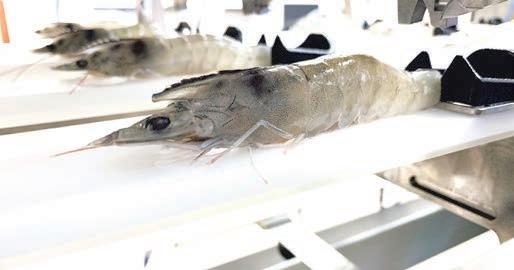
3 minute read
Revolutionizing shrimp processing
from Impact 2021
Designed and built at Nova-Tech Engineering in Willmar, the multifaceted ShrimpWorks automated platform may change the way fresh shrimp is processed for the consumer market. ShrimpWorks
Nova-Tech’s ShrimpWorks equipment poised to revolutionize shrimp processing business
BY CAROLYN LANGE | West Central Tribune
WILLMAR — Giving customers “revolutionary solutions” to help them “feed the world” was the driving force that engineers at Nova-Tech Engineering in Willmar used to develop an all-in-one piece of equipment that performs multiple tasks to prepare fresh shrimp for market.
The automated platform, called ShrimpWorks, has the potential to dramatically change how fresh shrimp are processed here in west central Minnesota’s burgeoning shrimp industry and in countries around the world — including those that rely on manual labor.
After nearly five years and several million dollars invested in the research and development stage, this year Nova-Tech launched ShrimpWorks, a customizable automated platform that can measure, sort, devein, peel and remove heads and legs from fresh shrimp.
Clients can choose which functions they want performed on their shrimp.
That flexibility allows the end-consumers, such as restaurants and grocery stores, to customize the products they sell and serve.

Designed and built at Nova-Tech Engineering in Willmar, the multifaceted ShrimpWorks automated platform may change the way fresh shrimp is processed for the consumer market.
ShrimpWorks
Shrimp farmers can program the ShrimpWorks platform “to do whatever they want it to do,” said Nova-Tech CEO Jim Sieben, during a presentation in July at the Partners in Ag Innovation conference in Willmar.
Sieben said ShrimpWorks has several unique features, including the ability to measure a shrimp before removing the head. He said typical equipment on the market cuts off heads based on the average size of a shrimp, which can mean lost shrimp meat when too much is cut off of large shrimp.
The ShrimpWorks machine moves to the “exact spot where the head is,” said Sieben.
Another patented component of ShrimpWorks is that shrimp can be deveined without splitting the back. Sieben acknowledges not having the “butterfly” look to a shrimp may take a while for customers to adjust to, but he said the quality of the shrimp meat is improved by removing the vein without splitting it open.
He said once major grocery stores start carrying shrimp without a split back, customers will adapt and seek it out.
Manon Claux-Conway, a product branding manager with ShrimpWorks, said because 90% of shrimp consumed in the U.S. comes from Asia, where labor is cheap, it’s important to find economical ways for domestic shrimp farmers to process their product in order to compete with imported product.
Using the same type of arrangement that Nova-Tech uses for its poultry equipment employed in 600 hatcheries worldwide, Nova-Tech will install and maintain the ShrimpWorks equipment and customers will lease it and pay for each function that it performs on each shrimp.
Nova-Tech has currently secured contracts to install ShrimpWorks at five different customer locations in North America and the European Union by this January and is targeting Latin America after that, according to Emily Field, a product branding manager at ShrimpWorks in Willmar.
Every week the company is seeing “an increase in demand” from potential clients who want to know more about ShrimpWorks, she said. “Everybody we talk to is just really excited for such a revolutionary product in the industry.”
In August, the ShrimpWorks marketing team attended an aquaculture conference in San Antonio, Texas, to introduce the new technology to vendors, including shrimp producers.
In September the team planned to attend food supply shows, where big names like Costco and Whole Foods were expected, to introduce the look of shrimp processed with ShrimpWorks.
ShrimpWorks has added employees and is leasing a separate building on the MinnWest Technology Campus in Willmar for production and continued research of future services and improvements to the equipment, said ClauxConway.
You may contact the author at clange@wctrib.com.










